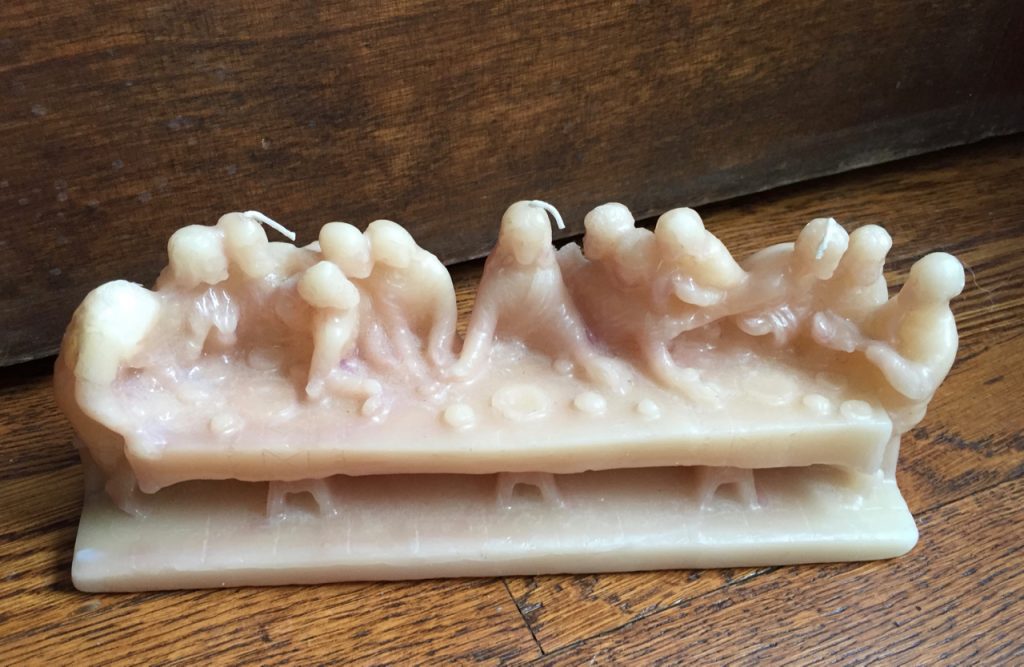While they were eating, he took a loaf of bread, and after blessing it he broke it, gave it to them, and said, “Take; this is my body.” Mark 14:22
At Dayton Correctional Institution (one of two prisons for women in Ohio), we started the “Journey to Resurrection” series of stories in late January. At the Montgomery County Jail, we started the same series on Ash Wednesday. This theme will run more or less from Epiphany through Lent and into Easter Season.
All but the last story we will engage are from Mark, chapters 14-16. The last story is from John, the story I call “Behind Locked Doors” (John 20:19-23) which seems tailor made for biblical engagement in prison or jail.
When we worked with the concluding episode of the story about Jesus’ last supper with his disciples (I call it “Bread and Wine”) the talking piece I brought was a candle my youngest daughter gave me some fifteen years ago. It was such a special candle, I could not bring myself to light it. One time several years after she gave it to me, she saw it and was quite distressed that I hadn’t burned it yet. Somehow burning that candle seemed a bit sacrilegious. On the other hand, that was its purpose, wasn’t it?
The second or third time I led Circles focused on the passion, death, and resurrection of Jesus during Lent, I remembered that candle. What a perfect talking piece for the story of the last supper! Now I knew its true purpose. Unfortunately, somewhere along the way one of the disciples lost his head (the one on the far left). I have glued it back, but it just keeps falling off.
So I told the women in the prison Circle of the Word about my daughter’s gift to me, and how she was distressed when she saw it hadn’t been burned. I told them how I now use it as a talking piece, even though one of the heads broke off. I pointed out the headless disciple. Then one of them said, “That’s Judas!” and we all had a very good laugh.
Funny as that was, there actually was a serious narrative connection between my damaged candle and the story. It was important to notice that Judas was among those to whom Jesus gave bread and wine. Judas was included in the “all” when Jesus gave the cup to his disciples and “they all drank from it.” Judas was included in the “many” when Jesus says, “This is my blood of the covenant which is poured out for many.”
Jesus knew Judas was going to betray him. That’s been established already in the story of the last supper. And yet, Jesus offered grace to even this most terrible enemy—a close friend and student who would betray him.
It was good to have laughter during the learning of this story. It is a hard one to internalize–not because it’s hard to remember, but because it is loaded with difficult emotional connections. And the stories of Mark 14-16 only get harder from here on out, until we finally reach our destination: resurrection.
When we engaged the story of “Bread and Wine” in the Sacred Stories class in the jail, I again used my special Last Supper candle with the headless disciple for a talking piece. Again I shared the story of my daughter’s gift.
As I started to pass the candle around for each person in the circle to agree to our “guidelines,” one woman spoke up with dismay in her voice to say she didn’t want to use the candle as a talking piece because if she dropped it she would feel terrible since it was a gift from my daughter. The thoughtfulness of these women never ceases to amaze me.
I honored the heartfelt request and we used our artificial candle for a talking piece that day in the jail.
Tell the story,
Amelia


